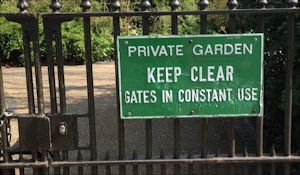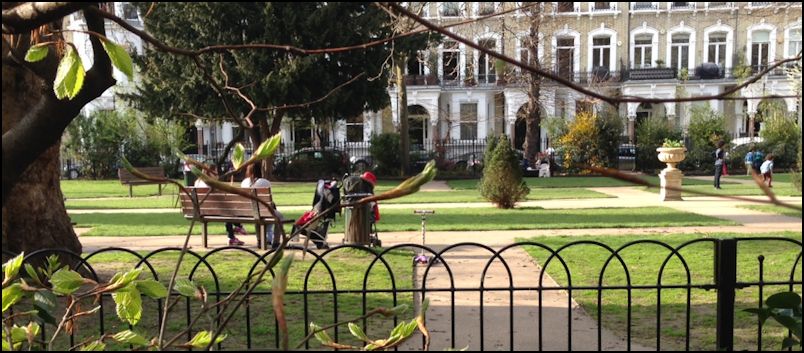by James A. Bacon
In the United States, we have gated communities. In the United Kingdom, the Brits have gated parks. They call them “key parks” because it takes a key to enter.
There is just such a park near where we are staying. The Bacon family walks past it every day on the way to the Underground. The beautifully manicured park has a grassy open area enclosed by trees, shrubs and a cast-iron fence. We tried to find a way in. Every gate was locked. We found it baffling. Only later were we told that key parks were a common feature around London.
In the U.S., we assume that parks are meant for the benefit of all. The existence of an institution such as private parks in a major city struck me as almost shocking. That’s one of the benefits of visiting other places — it challenges suppositions that there may be only one way to do a thing. Upon reflection, I can see the logic of the key park.
 I am conjecturing here: Redcliff Square was built as an amenity for the owners of the handsome buildings surrounding the park. Buy a house (or rent an apartment — I’m not sure who occupies the buildings along the street) and you enjoy access to the park. In the States, proximity to public parks adds value to nearby real estate. I suppose in London, proximity to a key park, which keeps out the riff-raff like American tourists, adds even more value to nearby real estate. (At least it does if you have a key.)
I am conjecturing here: Redcliff Square was built as an amenity for the owners of the handsome buildings surrounding the park. Buy a house (or rent an apartment — I’m not sure who occupies the buildings along the street) and you enjoy access to the park. In the States, proximity to public parks adds value to nearby real estate. I suppose in London, proximity to a key park, which keeps out the riff-raff like American tourists, adds even more value to nearby real estate. (At least it does if you have a key.)
London has a remarkable number of parks, some public, some private. Google a map of London and you’ll see not only the massive Hyde Park and Regents Park but dozens and dozens of smaller neighborhood parks. No matter where you live in the city, you’re only a couple of blocks from a park. (You may not have access to it, but at least you can enjoy the view while walking past it!)
Insofar as London parks are built by developers and maintained by private property owners, they provide a partial amenity for the general public at private expense. Personally, I like the idea of developers building parks and handing them over to local government for public maintenance and publnic enjoyment. But, then, we probably would end up with a lot fewer parks that way.
Update: According to the London Evening Standard, municipal authorities are providing funding for seven new parks and the New London Landscape is brainstorming all kinds of new ideas. “Among the exciting new range of watery spaces proposed are floating gardens in Docklands, a linear lido along Regent’s Canal … and a reinstated River Fleet channel as a new low-line park. The subterranean river, below Fleet Street in the City, has been covered since 1769. It would be opened up below street level, with pedestriran footpaths either side.”




